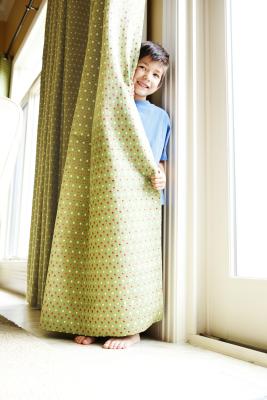Window treatments beautify your space and provide privacy as well. Tempting as it might be to spend on elaborate custom treatments when you first move in to a home, waiting a while saves you from making expensive mistakes. Make note of your personal needs in a space. Decide whether you need to filter glare, block neighbor’s views or just soften the look of a window. Inexpensive temporary blinds or curtains fill in while you ponder your options.
Basics
Although not an exciting step, determining your budget is wise before falling in love with luxurious window treatments. Custom drapes cost more than ready-to-hang options, and if you are handy, homemade curtains are an economical solution. Decorate a room first and match window treatments to the look, or choose a special design and work around them.
Window Function
When you plan window treatments, keep how the window functions in mind. Your windows might open out, or in, up, or not at all. Inward-opening casement windows make blinds hung on the windowsill above them awkward. Full-length heavy drapes that cascade onto the ground look elegant and rich, though when you open and close the windows continuously, they can be inconvenient and cumbersome.
View
You might use window treatments to soften bright light or an unattractive view. Blinds provide excellent privacy and those with adjustable louvers or slats allow you to control who sees what, where. When you select blinds, consider how thick they are when fully drawn up. The compacted slats or folded fabric that block the attractive view at the top of your window might make you regret the choice. Softening the look of blinds with a swag of fabric on the top of the window works well in more traditional decor.
Curtains
Curtains are a classic choice in window treatments. Some options include tailored curtains that feature pleats or folds. Tab-top curtains that attach to curtain poles with fabric loops look casual and fit contemporary decor. Insulated curtain fabric helps keep heat or cold out. Some “blackout” fabrics let you make bedrooms dark for sleeping late, even in rooms with an Eastern exposure. Typically, curtains hang either to the bottom of the windowsill or opening, or all the way to the floor. Cafe curtains in kitchens cover only the bottom half of the windows.
Blinds
Blinds or window shades are sheer or opaque. Roll-down shades are simple solutions for privacy concerns. Some new products feature fabrics that filter out light and heat. Manufacturers feature different fabrics to match your interior design, or select your own and pay a professional to turn it into a shade. Some blinds come in soft materials that filter rather than block views. Horizontal or vertical slats of fabric adjust to increase or decrease the amount of light allowed through.





